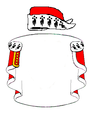Mantle and pavilion (heraldry)
- View a machine-translated version of the German article.
- Machine translation, like DeepL or Google Translate, is a useful starting point for translations, but translators must revise errors as necessary and confirm that the translation is accurate, rather than simply copy-pasting machine-translated text into the English Wikipedia.
- Consider adding a topic to this template: there are already 5,543 articles in the main category, and specifying
|topic=will aid in categorization. - Do not translate text that appears unreliable or low-quality. If possible, verify the text with references provided in the foreign-language article.
- You must provide copyright attribution in the edit summary accompanying your translation by providing an interlanguage link to the source of your translation. A model attribution edit summary is
Content in this edit is translated from the existing German Wikipedia article at [[:de:Wappenmantel]]; see its history for attribution. - You may also add the template
{{Translated|de|Wappenmantel}}to the talk page. - For more guidance, see Wikipedia:Translation.
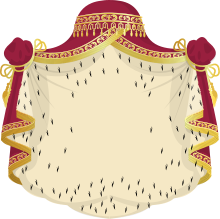

In heraldry, a mantle is a symbol of sovereign power and is generally reserved for royalty. In some cases, its use has also been granted to other nobles, in recognition of particular merits. In ordinary rendering, the mantle is usually crimson and lined with ermine.
Certain coats of arms may also display a pavilion (similar to a baldachin) surmounting the mantle. The pavilion is said to be the invention of the Frenchman Philip Moreau.[1] Some republics have displayed a mantle and pavillon in their coats of arms, contemporarily Serbia.
While common in continental European heraldry, the mantle and pavilion is absent in English and Scottish heraldry.[2]
Mantle and pavilion should not be mixed with Mantling.
Gallery
Mantles
Royal mantles
-
 Greater arms of Sweden, featuring a purple mantle but with no pavilion
Greater arms of Sweden, featuring a purple mantle but with no pavilion -
 King Carl XVI Gustaf of Sweden's former arms as crown prince, with a blue mantle reflecting the Swedish princely mantle
King Carl XVI Gustaf of Sweden's former arms as crown prince, with a blue mantle reflecting the Swedish princely mantle
Non-royal mantles
-
 Heraldic ornaments of a French duke and peer
Heraldic ornaments of a French duke and peer -
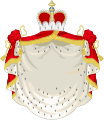 Mantle and princely hat of a Prince of the Holy Roman Empire
Mantle and princely hat of a Prince of the Holy Roman Empire -
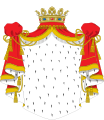 Mantle and coronet of an Italian duke
Mantle and coronet of an Italian duke -
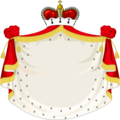 Mantle and princely hat of a Polish prince
Mantle and princely hat of a Polish prince - Historical mantle and chapeau of a Scottish feudal baron
-
 Mantle and coronet of a Grandee of Spain
Mantle and coronet of a Grandee of Spain -
 Mantle and princely hat of a Russian prince
Mantle and princely hat of a Russian prince
Mantles of chivalric orders
-

-
 Arms of Maximilian von Fürstenberg with the mantle of the Order of the Holy Sepulchre
Arms of Maximilian von Fürstenberg with the mantle of the Order of the Holy Sepulchre -
 Arms of the Sovereign Military Order of Malta
Arms of the Sovereign Military Order of Malta -
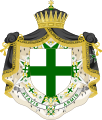 Arms of the Order of Saint Lazarus
Arms of the Order of Saint Lazarus
Mantles with pavilions
-
 Napoleonic heraldic mantle and pavilion, with a Napoleonic crown
Napoleonic heraldic mantle and pavilion, with a Napoleonic crown -
 Coat of arms of the Dutch monarch, with a mantle and pavilion
Coat of arms of the Dutch monarch, with a mantle and pavilion -
 Grand coat of arms of the Kingdom of France
Grand coat of arms of the Kingdom of France -
 Greater coat of arms of the Russian Empire
Greater coat of arms of the Russian Empire -
 Coat of arms of the Karadjordjevic dynasty
Coat of arms of the Karadjordjevic dynasty
See also

References
- v
- t
- e
- Armiger
- Augmentation
- abatement
- Ancient and modern
- Alliance
- Blazon
- Cadency
- Canting
- Field
- Fraud
- Marshalling
- quartering
- impalement
- National traditions
- Societies
- Coat of arms
- Crowns and coronets
- Crest
- Compartment
- Escutcheon
- Helmet
- Mantling
- pavilion
- Motto
- slogan
- Supporter
- Torse
- Attitudes
- Erasure
- Fimbriation
- Lines
| Ordinaries | |
|---|---|
| Beasts | |
| Birds | |
| Other |
|
| Legendary |
|
| Plants | |
| Knots |
- Rule of tincture
- Tricking
- Hatching
| Metals |
|
|---|---|
| Colours | |
| Furs | |
| Stains | |
| Rare metals1 |
|
| Rare colours1 |
|
| Realistic |
|
- 1 Non-traditional, regional, or rarely used (sometimes considered unheraldic)
- List of oldest heraldry
 Heraldry portal
Heraldry portal - resources
 | This heraldry-related article is a stub. You can help Wikipedia by expanding it. |
- v
- t
- e






